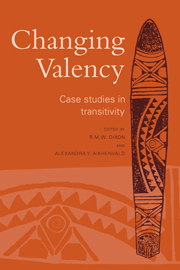Book contents
- Frontmatter
- Contents
- List of contributors
- Preface
- List of abbreviations
- 1 Introduction
- 2 A typology of causatives: form, syntax and meaning
- 3 Valency-changing derivation in Central Alaskan Yup'ik
- 4 Transitivity and valency-changing derivations in Motuna
- 5 Transitivity in Tariana
- 6 Voice and valency in the Athapaskan family
- 7 Valency-changing derivations in K'iche'
- 8 Valency-changing derivations in Dulong/Rawang
- 9 Valency-changing and valency-encoding devices in Amharic
- 10 Complex verb collocations in Ngan'gityemerri: a nonderivational strategy for encoding valency alternations
- 11 Valency-changing derivations in Tsez
- 12 Creek voice: beyond valency
- Index of authors
- Index of languages and language families
- Subject index
5 - Transitivity in Tariana
Published online by Cambridge University Press: 02 February 2010
- Frontmatter
- Contents
- List of contributors
- Preface
- List of abbreviations
- 1 Introduction
- 2 A typology of causatives: form, syntax and meaning
- 3 Valency-changing derivation in Central Alaskan Yup'ik
- 4 Transitivity and valency-changing derivations in Motuna
- 5 Transitivity in Tariana
- 6 Voice and valency in the Athapaskan family
- 7 Valency-changing derivations in K'iche'
- 8 Valency-changing derivations in Dulong/Rawang
- 9 Valency-changing and valency-encoding devices in Amharic
- 10 Complex verb collocations in Ngan'gityemerri: a nonderivational strategy for encoding valency alternations
- 11 Valency-changing derivations in Tsez
- 12 Creek voice: beyond valency
- Index of authors
- Index of languages and language families
- Subject index
Summary
Introduction
This chapter considers transitivity alternations in Tariana. There are two valency-reducing operations and four valency-increasing causativizing mechanisms; there is also a valency-increasing mechanism distinct from both causatives and applicatives. Transitivity alternations in Tariana provide evidence as to what grammatical relations must be distinguished in this language.
The chapter is organized as follows. I describe typological properties of Tariana in §2. Then, in §3, I discuss valency-reducing derivations. Valency-increasing mechanisms are analysed in §4. Some conclusions and typological perspectives are given in §5.
Typological characteristics of Tariana
Tariana is predominantly head-marking with a few elements of dependent-marking. There are three open word classes – nouns, verbs and adjectives. Relations between word classes and functional slots in a clause are summarized in appendix 5.1. The language has a complicated verb structure, and a large system of classifiers (Aikhenvald 1994a). Constituent order is free, with a strong tendency towards verb-final order. How grammatical relations are marked is discussed in §2.1. Verb structure is discussed in §2.2; and in §2.3 we look at transitivity classes of verbs.
Grammatical relations
Grammatical relations in Tariana are marked in two ways.
Cross-referencing on the verb
Verbs in Tariana divide into two classes: those which take prefixes (cross-referencing, relativizing and negative) and those which do not. Active transitive and intransitive verbs obligatorily take cross-referencing prefixes to mark the A/Sa constituent (following the terminology in Dixon 1994). Stative verbs (So) and verbs of physical states (Sio) do not take any cross-referencing markers. This division roughly corresponds to the morphological distinction between active and stative intransitive verbs inherited from Proto-Arawak.
- Type
- Chapter
- Information
- Changing ValencyCase Studies in Transitivity, pp. 145 - 172Publisher: Cambridge University PressPrint publication year: 2000
- 6
- Cited by

